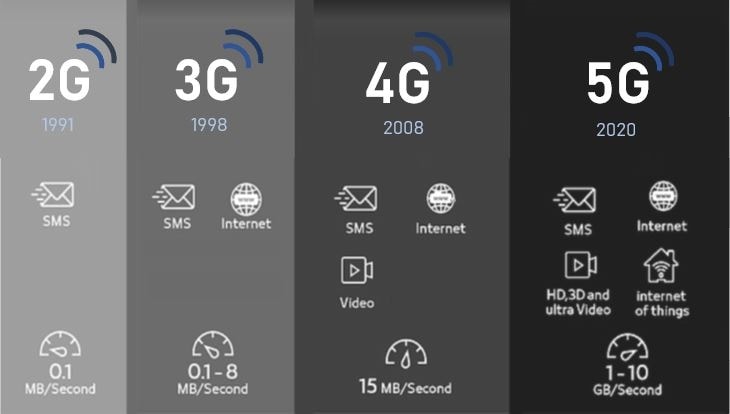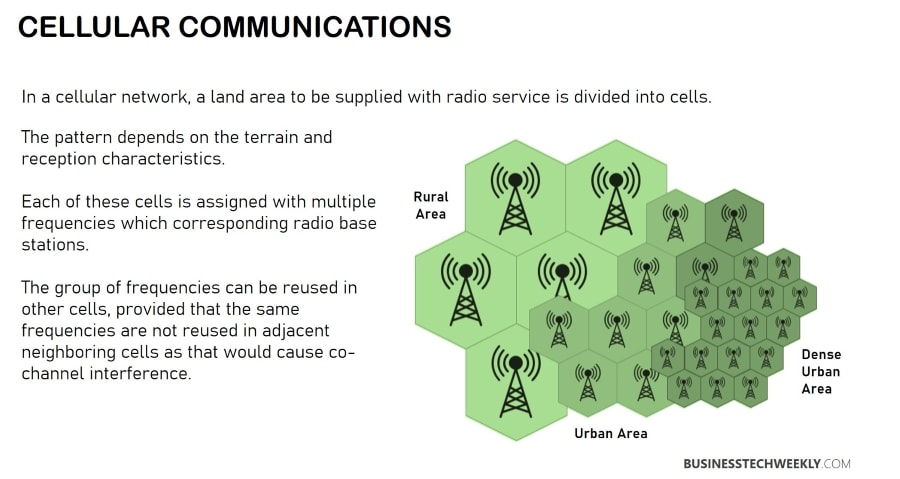Cellular networks: A quick guide for Business users

What are cellular networks, and how can you use them for data and voice communications in your business?
Cellular networks are high-speed, high-capacity voice and data communication networks that support cellular devices through enhanced multimedia and seamless roaming.
With mobile devices growing in popularity, these networks are being utilised for more than just entertainment and phone calls.
They have become the principal mode of communication for financial-sensitive corporate transactions, life-saving crises, and life-/mission-critical services.
On this page:
Understanding Cellular Phone Technology
Cellular technologies provide more options for mobile device networking. Because cellular networks have global coverage, they are frequently available in locations where other types of networking, such as local area networks (LANs), are not.
As such, you can use these technologies with WLANs to ‘roam’ and stay in touch when travelling.
Cellular network technologies
Technologies connected with cellular phone services include:
- 3G – Third-generation data transmission systems providing data rates comparable to traditional broadband networks
- 4G – fourth–generation data transmission systems providing data rates similar to conventional broadband networks
- 5G – fourth–generation data transmission systems providing data rates comparable to traditional broadband networks
- Global positioning system (GPS) – enables a device’s position to be precisely located
- GSM and GPRS – Global System for Mobile Communication and General Packet Radio Service. Services for data transmission delivered via cellular networks
- Multimedia messaging services (MMS) – provides for the transmission and reception of different types of communications such as pictures, audio, and video
- Short messaging service (SMS) – text messaging service
The 5th generation of mobile internet connectivity, or 5G, is still in its early stages. It is based on modern radio technology that operates at higher frequencies. It promises substantially quicker data download and upload speeds, more coverage, and more consistent connections.
However, for the time being, its primary job is to augment the capacity of current 4G networks rather than to replace them.
Also read: What opportunities does 5G present for small businesses?

How do Cellular Networks work?
Cell phones function in much the same way as the other wireless gadgets we’ve discussed. Using radio waves, signals conveying voice, text, and digital data are sent from one device to another.
In the case of cellular networks, data is transmitted across a global network of transmitters and receivers. Other technologies use a central hub in a limited network of devices (as with Wi-Fi) or even directly from device to device (as with Bluetooth).
Cells in a Network
A mobile phone network is made up of thousands of overlapping geographic locations, known as cells. A typical cellular network is represented as a mesh of hexagonal cells, each with its base station in the centre.
The cells overlap slightly at the edges to guarantee that users are always within range of a base station.

The base station is at the heart of each group of cells. The base station serves as the hub for those cells – for that specific portion of the network. Not for the entire network.
An individual phone transmits RF signals received by the base station and re-transmitted from the base station to another mobile phone. Transmission and reception take place on two slightly different frequencies.
Base stations are linked by central switching centres, which track calls and transfer them from one base station to another when callers move between cells. The handoff is (hopefully) seamless and invisible.
Each base station is also linked to the main telephone network, allowing mobile calls to be routed to landline phones.
The size of the cells varies based on how many calls are made within that geographic area.
The smallest cells, which may only cover a few city blocks, have the highest population density and hence the greatest need for service. The largest cells are typically found in rural locations with a lower population density per square mile.
Carrying a Two-Way Radio
The portable mobile phone is the source of all transmissions within a cellular network. A mobile phone is essentially a two-way radio, with both a low-power transmitter (for data transmission) and a receiver (to receive data).
Because mobile phones broadcast within a relatively narrow range—inside the current network cell—they can get away with such low-power transmitters.
A phone’s signal is not essential or desirable to reach beyond the present cell; this allows numerous cells to use the same broadcast frequencies without fear of interference.
Benefits of Cellular Networks
People’s business practices are altering as a result of mobile technologies. It improves people’s ability to stay connected, work from anywhere, and be productive while on the go.
Although making it easier to conduct business, mobile technology enhances business processes such as customer service and corporate productivity, as well as the possibility of your company growing.
Mobile technology
Mobile technology is essential in today’s business. Because of its versatility, it provides various benefits while also posing significant hazards to the organisation. It is critical to assess both the benefits and drawbacks of employing mobile technology in a company.
Workers can use mobile devices to access the internet, mobile business applications, wireless ordering, billing and online purchasing, email accounts, and other services. This provides them with significantly more flexibility, allowing them to continue working remotely.
3G/4G/5G networks enable faster data transfer and the creation of additional handset-based real-time commercial apps. GSM and GPRS data services are likely to be accessible for many years.
However, due to the faster data speeds available with 4G and 5G, means these will eventually replace the other two.
Rapid advancements in cloud technology are increasing the usage of mobile devices in business, allowing for more flexible working habits and internet-based service access.
Advantages of Cellular Networks
- It delivers voice/data services when travelling and links fixed and wireless phone subscribers.
- Because of its wireless nature, it is employed in regions where wires cannot be carried out.
- It is simple to maintain.
- It is simple to upgrade the equipment.
- When mobile phones are turned on, both mobile and fixed subscribers are immediately linked to the cellular network. All handshake signals between the mobile and base station are exchanged automatically.
Disadvantages of Cellular Networks
- It provides a lower data rate than wired networks such as fibre optics. The data rate varies according to cellular technologies such as GSM, CDMA, LTE.
- Multipath signal loss has an impact on macro cells.
- Capacity is limited and is dependent on the channels/multiple access strategies used to service users.
- Because the communication is over the air, it has security flaws.
- The cost of establishing cellular network infrastructure is higher.
- Physical barriers, environmental factors, and interference from other wireless devices all impact wireless communication.
- The installation of antennas for cellular networks necessitates the use of space and a base tower. This is time-consuming and involves much effort.
The role of cellular networks
While the top five economies account for 55.7 per cent of worldwide cellular traffic demand, cellular connection is a supplemental service in most of these economies.
This is in stark contrast to nations like Lao PDR and Ghana, which account for a negligible portion of worldwide traffic but where cellular accounts for 87 per cent and 95.9 per cent of entire GDP demand, respectively.
The rising significance of cellular networks in delivering Internet connection in many parts of the world supports the argument for include these networks in these economies’ critical infrastructure.

